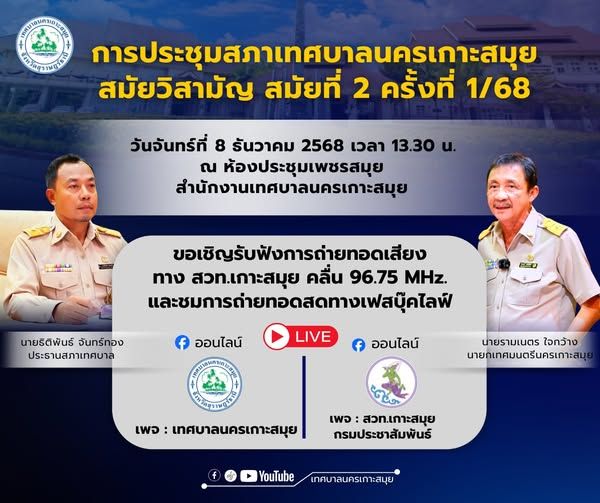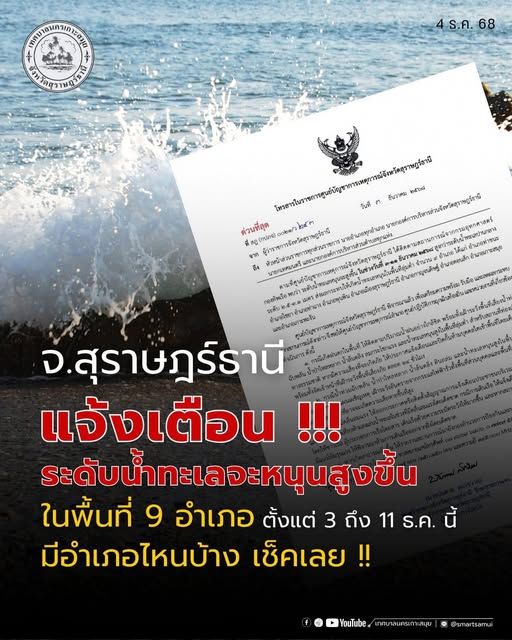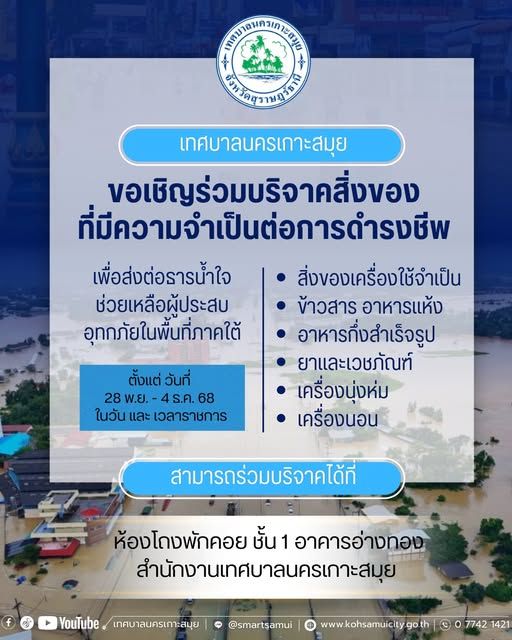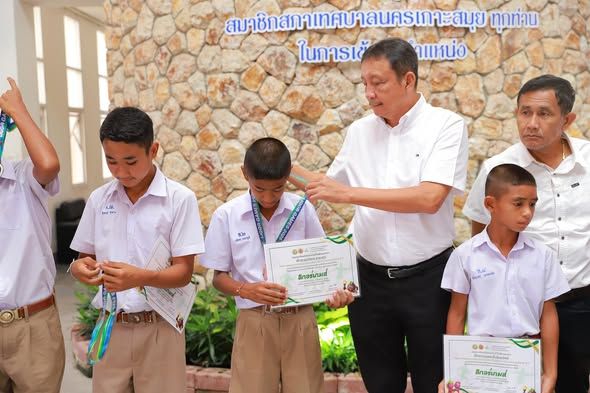Koh Samui is set to redefine its urban landscape with a groundbreaking City Master Plan that prioritizes sustainable development and environmental preservation. Community experts and local government are collaboratively crafting a visionary blueprint to guide the island’s growth for the next decade, ensuring a harmonious balance between tourism and ecological protection.
KohSamui #SustainableTourism #ThailandTravel #UrbanDevelopment #IslandLife #SmartCity #EcoTourism #TravelThailand #ResponsibleTravel #IslandPlanning
Koh Samui, a major island in Surat Thani Province, is a prominent hub for tourism, real estate, and commerce in Southern Thailand. The Koh Samui City Master Plan serves as the foundational document guiding urban development, land use, infrastructure expansion, and environmental management. The original master plan was established through ministerial regulation and came into effect on December 1, 1995. The first revision was implemented on July 25, 2006, and expired on July 24, 2013.
In response to increasing urbanization and dynamic economic shifts, the responsibility for urban planning was delegated to Koh Samui’s local administrative organization in January 2009. A significant revision process was initiated in 2014, using a consulting firm to update the plan to modern requirements. However, the introduction of the City Planning Act, 2019, necessitated further updates to comply with new legal standards, including enhanced public participation and additional procedural steps.
Objectives and Scope of the Second Revision
The second revision of the Koh Samui City Master Plan is designed to ensure the island’s development aligns with contemporary needs, stakeholder expectations, and regulatory frameworks. The revision specifically addresses:
- Recent and anticipated economic growth
- Urban expansion pressures
- Sustainable land use and zoning
- Infrastructure improvement
- Integration of national and provincial development policies
The revision encompasses the full areas of Bophut, Maenam, Lipa Noi, Na Mueang, and Mareet sub-districts, as well as portions of Ang Thong and Taling Ngam sub-districts. Pisuth Technology Co., Ltd. was appointed as the consulting firm to carry out the revision in accordance with the City Planning Act, 2019.
Public Participation Process
Public participation is a pivotal element in the revision process. The meeting held on March 14, 2025, at the Koh Samui Municipality Office, marked the second round of three required public hearings under the new legal framework. These hearings are intended to:
- Gather information, feedback, and suggestions from stakeholders
- Foster transparency and inclusiveness in urban planning
- Promote understanding of city planning processes and impacts
- Build consensus on development priorities and strategies
Attendees included municipal executives, council members, government department heads, representatives from the Department of Public Works and Town & Country Planning, provincial agencies, private sector operators, business and tourism associations, real estate entrepreneurs, community network partners, and members of the general public.
Expert Insights and Frameworks
The meeting featured presentations from leading experts, including Asst. Prof. Dr. Panayu Chairattananon (urban planning) and Dr. Karn Chalermwongphan (transportation and logistics). Their input focused on:
- Formulating physical development guidelines for Koh Samui
- Integrating transportation and logistics considerations into urban planning
- Ensuring that growth is managed in an environmentally responsible manner
- Encouraging innovative solutions for infrastructure and public utilities
These frameworks are intended to guide the preparation of regulations and the draft master plan, ensuring a comprehensive approach to the island’s development.
Engagement with Key Stakeholders
The hearing provided a platform for a broad range of stakeholders to voice their perspectives, including:
- Business owners and real estate developers
- Tourism sector representatives
- Community committees and associations
- Career network partners and local residents
By opening the floor to diverse opinions, the planning process aims to create a balanced master plan that reflects economic, social, cultural, and environmental considerations.
Legal and Regulatory Context
The second revision strictly follows the procedures outlined in the City Planning Act, 2019. This law emphasizes:
- Increased public consultation and transparency
- Evidence-based decision-making
- Multi-stage review and approval processes
- Alignment with broader urban and regional development policies
In addition to public hearings, the process requires thorough documentation and integration of feedback into the planning database, ensuring that proposed regulations and zoning changes are responsive to local needs.
Area Coverage and Key Development Issues
The areas addressed in the master plan cover most of Koh Samui’s major sub-districts, with special attention to:
- Urban sprawl and land use conflicts
- Preservation of natural and coastal resources
- Transportation and mobility enhancements
- Management of utilities and public services
- Housing, tourism infrastructure, and economic diversification
The revision also seeks to anticipate and address future trends, such as climate change resilience, eco-tourism, and smart city initiatives.
Public Information and Participation Opportunities
In addition to the main public hearing, a separate session for business operators and private sector representatives was scheduled for the afternoon, emphasizing the importance of sector-specific feedback. The municipality encourages ongoing public engagement through multiple channels:
- Direct contact with the Engineering Office, Building Control and City Planning Division (Tel. 077-421-421 ext. 106 or 108)
- Live broadcasts of meetings to facilitate remote participation and broader outreach
- Distribution of meeting summaries and draft plans for community review and comment
These measures are designed to ensure that all segments of the community have an opportunity to shape the future of Koh Samui’s urban landscape.
Frequently Asked Questions
Frequently Asked Questions: Koh Samui City Master Plan
What is the main purpose of the Koh Samui City Master Plan revision?
The second revision of the Koh Samui City Master Plan aims to guide the island’s growth while balancing economic development with environmental sustainability. This process addresses current and future challenges such as urban expansion, land use, infrastructure improvement, and the integration of national and provincial policies. The updated plan ensures that Koh Samui’s urban development is in line with modern needs, stakeholder expectations, and the latest legal standards.
How is public participation incorporated into the planning process?
Public involvement is a central pillar of the revision process. The City Planning Act, 2019 requires multiple public hearings and diverse stakeholder engagement to ensure transparency, inclusiveness, and responsive decision-making. Meetings are held for local residents, business owners, government officials, and experts to voice concerns, provide feedback, and help shape the plan. Additional channels—such as live broadcasts and direct contact with city planning offices—are available to ensure broad community input.
Which areas and development issues are covered by the master plan update?
The master plan update covers most major sub-districts of Koh Samui, including Bophut, Maenam, Lipa Noi, Na Mueang, and Mareet, as well as parts of Ang Thong and Taling Ngam. Key issues addressed include urban sprawl, land use conflicts, preservation of natural and coastal resources, improved transportation and utilities, housing, tourism infrastructure, and economic diversification. The revision also looks ahead to trends like climate change resilience, eco-tourism, and smart city initiatives, ensuring holistic and sustainable urban growth.




